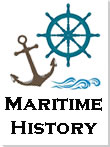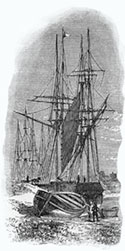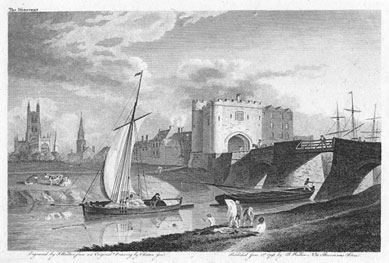Maritime History of Newport
By Peter Brown
© Peter Brown 2024
The seventeenth century
We can only estimate the population sizes before 1801, when the census recorded only 1135 inhabitants of Newport and 667 of Caerleon.[1] As Newport was a busy market town for centuries before that, it seems likely that the population was always less than 1000 but close to that figure. The trade references to Newport and Caerleon suggest they were significant distribution centres for a much broader area by the mid-17th century. References to tobacco and hemp also indicate the presence of tobacco works in both Newport and Caerleon and perhaps a ropery at Caerleon.[2] There is also a reference from 1648 that “the tobacco ships of Bristol” were discharging part of their cargoes at Newport when homeward bound.[3]
In 1635, Ship Money was imposed in Monmouthshire. This was a tax of Medieval origin levied intermittently in England until the middle of the 17th century and was one of several taxes that English monarchs could levy by prerogative without the approval of Parliament. The attempts of King Charles I from 1634 onwards to levy Ship Money during peacetime and extend it to the inland counties of England without parliamentary approval provoked fierce resistance, and it was one of the grievances of the English propertied class in the lead-up to the English Civil War.[4] The tax on Newport in 1635 was £23 (compared with £25 for Liverpool and £800 for Bristol), and in the following year, James Williams, the Mayor of Newport, requested “that he not be pressed for £29 9s. 9d. ship money, for three weeks, St. James’ Fair having hindered him.”[5]
In Newport, the area between the castle and the Town Pill had been the location of the quays since Medieval times, but 17th-century expansion saw the quayside extend south of the Town Pill to accommodate the steady growth of trade. The new quay was known as the Waterside Key and Wharf.[6] A grant in 1668 to Walter Nicholas allowed him to erect warehouses and build slips to enhance the port facilities.[7] That year also saw the earliest reference to the funding for a water bailiff, who had “liberty of anchorage and wharfage and power to act as water bailiff upon the Usk within the liberty of the town.”[8]
The records also contain some references to the dangers of shipping in the later 17th century. In October 1670, part of the hull of a Dutch ship of about 500 tons was put ashore near Newport “through the storms", and in 1675, “A considerable vessel was cast away betwixt Newport and Bristol, laden with logwood, elephant’s teeth, etc and 14 men drowned. Some say they were from Guinea, some from Jamaica, bound for London.”[9]
Trade
The Joseph of Caerleon was actively engaged in the export of wheat, oats and butter to Ireland in 1600. The ship made two or three trips a month that year, and it also called at other ports in between and frequently visited Bristol.[10]
Records for 1601-2 show “Le Speedwell de Newporte” (30 tons) moving 10 tons of salt from Croiswicke (Le Croisic in Brittany) to Cardiff, and 6 tons of Welsh iron and 6 pairs of millstones from Newport to Beaumaris. “Le Elizabeth de Bristol” (24 tons) carried malt, beans and oats from Newport to Dublin, and “Le Roebuck de Bristol” carried 3 pairs of millstones over the same route. The “Jonas of Newport” (18 tons) carried 4 loads of Welsh iron – 59 tons – from Newport to Bridgwater.[11] The merchant for the iron was Richard Hanbury (1538–1608), who ran the ironworks at Pontypool, where the iron was presumably made before being transported to Newport.[12]
A record from 1619 in the State Papers confirms the importance of Caerleon in trade with Bristol, but this still seems to be using relatively small boats.[13]
The carrying of butter to Ireland was imposed on the ships by the State; otherwise, butter was not to be exported. The Merchant Venturers of Bristol obtained a share in the patent in 1619, permitting the export of a limited quantity of butter, and this situation existed until the Restoration in 1660.[14] The price of butter at that time (1619) was 3d (3 old pence) per pound in Cardiff, Newport and Caerleon, and strangely, did not change for a long time. The letters of John Byrd, the Collector of Customs for the Port of Cardiff from 1647 to 1662, show that the price was still the same in 1650. Two Caerleon men, George Langley and Roger Jones, yeomen, held bonds with the Merchant Venturers, permitting them to buy butter to be exported by the Company.[15] From 1627–34, Welsh butter from Newport and Caerleon was exported to France regularly.[16] The Guift of “Carlion”, the Mary Rose of Newport, and the Jonas of Newport all transferred butter to other ships for French destinations such as Rochelle and Bordeaux.
On 15th April 1623, the “Grace of Newporte”, with Walter Thomas as Master, sailed from Bristol for Cardiff for Sir Thomas Morgan, knight, carrying “v tonns lead in sowes”.[17]
The Controller’s entries for 1635-36 add more details about overseas trade:[18]
- The “Mary Rose of Newporte” carried “Welch butter” to be put aboard the Charles of Bristol (250 tons) bound for Lyshborne (Lisbon). The Charles was a Bristol privateer mounting 30 guns.
- The Mary carried “ffrench barley” and “ffrench rye” to be shipped aboard the Sister of Bristol (120 tons) for Cales (Cadiz).
- The Jonas of Newport carried butter for transfer to the David of “Bristoll” (250 tons) for Rochelle.
- In 1634, The Margret of Queensferry (200 tons) shipped at Newport 47 kilderkins (barrels containing 18 imperial gallons) of butter for France.[19]
John Byrd described Caerleon in 1649 as a town engaged in a “very great trade” with Bristol for “most things in general”. The following year, he commented on how Caerleon commanded “far more trade” than Newport, while in 1653 he noted that Caerleon was known for its trade in expensive, luxury items.[20] Byrd’s later correspondence includes a letter sent in 1664 to his son Mattias, who was in the Navy, and this letter gives us an insight into cross-Channel trade when Byrd wrote:[21]
Sonne Matt. This daye I sent by way of Bristoll a peece of flannen, the best that coulde be had yesterday in Abergaby faier, it cost here 15½d. per ell, being 36 ells, and 18d. I sent with it to pay for carryadge from Bristoll.
The Cardiff Port Books indicate the relative importance of shipping through Newport and the district in 1656. Of the 20 parchment leaves, 3½ are devoted to Cardiff, 3 to Newport, 3½ to Caerleon and 2 to Chepstow.[22] The details provide a complete account of the carriage of goods in the area and the ships and people involved.[23] The Newport ships involved were the Speedwell and the Mary Rose. These ships carried a wide range of goods from Bristol, including: beer and wine; “Virginian Tobacco”; groceries, salt and bread; cotton wool and soap; wheat, malt and hops; “raw iron”, lead, brass, pewter and iron wares; “deale boards”; linen, mercery, silk, drapery, sack cloth, broad cloth, upholstery, haberdashery and “apparel”; tanned leather; “trayne” (whale oil); “dickers (units of 10) of pates (?)”,[24] and “three hundred pound in money”.
The port books for Caerleon in 1656 record the Caerleon ships as the Guift, the John, and the Mary Constant.[25] The produce they brought from Bristol was similar to the Newport ships but also included cheese, pepper, “fower flitches bacon”, “twoe packes knives”, lime, yarn, “one bagge of feathers”, “twoe peeces tyke”, “three dozen of whalebone”, “oyle and trayne”, “boxes of tobacco pipes”, “hempe and towe”,[26] “Barbados tobacco”, household goods and “one cake of rozen” (possibly resin used to make varnish).[27]
Other vessels transporting goods to the Usk in 1656 were the Adventure of “Tintarne”, the Martha and Joane of Bristol, the John of “Glocester”, the Mayflower of “Cardyffe”, and the John, the Roger, the Eliza and the Charles of “Tewxbury”. Several entries record the movement of sow iron from Chepstow, Bristol and Aberthaw. Other imports were salt and lime from Bristol and grain and bread from Gloucester.[28]
In 1656, a barque called the Guift of “Carlion” (about 20 tons) carried iron, “ffriche” (frieze – course woollen fabric) and “mettle”, while the Mary Rose of Newport (20 tons) carried iron, butter, tanned hides and raw calve skins.[29] In 1658, a barque called the Mary of Carlyon (18 tons) – Master William Watkins – carried iron, “ffryches”, wool, oatmeal, butter and £100 “in money”.
Apart from the coastal trade, most foreign trade in the Channel was managed by Bristol. In Wales, Swansea was the busiest port, but the Usk also worked some continental trade, and in 1662, the Trynity of “Croiswick” (20 tons) came to Newport.[30] A few years later – in 1673 – the St. Barb of “Newporte” (about 45 tons) arrived from Bordeaux laden with French wines, while the Ann and Mary of “Nupt” carried butter, “calveskins”, wheat and “lether”.[31]
The successors of "Le Steven" and "Le Griffin" appeared in 1686 in the Tredegar of Newport (24 tons) and the Endeavour of Caerleon (30 tons).[32] On one trip, the Tredegar brought from St. Martins (Saint-Martin-de-Ré) “One ton of ffrench wine, foure h’hds (hogsheads) of brandy, eleaven wey and half of ffrench salt.” The Endeavour also brought “ffrench salt and wine” from Avry (Le Havre). In 1687, the Swallow of Newport (20 tons, English built) brought from St. Martins “twenty foure weys of ffrench salt and one chest cont two hundred drinking glasses.”
By the end of the 17th century, we can see much maritime trade in Newport and Caerleon. This provided a large volume of work for many people: those who produced the goods for export; the carriers, storers and loaders for the ships; the masters and crews of the ships; and finally, the distributors for the goods imported.[33] The maritime trade was shaping the economy and the lives of all the local people, as it continued to do in the following centuries.
Ships
As previously, we know the trade occurring in the 17th century but have few details of the types of ships involved. From the late Medieval period, trows were used for local carriage on Severn, Wye, and the Bristol Channel. These small, open, flat-bottomed boats were a common sight as the everyday workhorses for local trade. Early trows had a single mast mounted to be lowered backwards onto the deck to travel under bridges. This was useful for traffic to Caerleon that needed to pass under Newport Bridge. With some adaptation to the keel to improve stability, trows were also surprisingly seaworthy. After centuries of good service, trows were phased out in the early 20th century, and the Ironbridge Gorge Museum Trust has preserved the last one to operate, the Spry. Built at Chepstow in 1894, the Spry used to travel to Newport in the late 19th century.[34]
Severn trows navigating a bridge at Gloucester in 1798. This shows the trow on the right lowering the mast backwards to travel under a bridge.
From a drawing by C. Catton, reproduced under Creative Commons licence.
Boats operating on a domestic basis varied in size between 20 and 60 tons, whereas vessels that travelled to the continent were much larger, being able to carry between 100 and 200 tons.[35]
From the late 17th century we find records of the Gwyn (or Gwin) family of Caerleon that owned ships, and in her will of 1672 Mary Gwyn left “to my two sons, William and Phillipp Gwyn… boat and barke called the Mary of Carlyon…” with the condition that they “pay her debt of £40 first”. It seems that the condition was not fulfilled because the Mary was not mentioned in the inventory of Mary Gwyn in 1673. Instead, a boat called The Five Brothers is in the inventory as well as in the will. This may have been a rowing boat or a boat with a sail that could not carry any mentionable cargo.[36]
In 1674–5, a consortium of local merchants commissioned the first ship of any size to be built in Newport. The Tredegar of Newport cost £605, with the principal shareholder, John Morgan of Tredegar, contributing £453.[37] The ship traded with Barbados but appears to have operated mainly out of Bristol.
The Hanbury family of Pontypool appeared again in the records in 1695, when they purchased a ship called the Phillipp and Mary from Phillipp Gwynn of Caerleon.[38] Three years later, in 1698, the Gwyn Trowe carried iron for Caple (Capel) Hanbury.[39]
The maritime trade of Caerleon continued well into the 19th century, but the ascendency of Newport was unstoppable in the 18th and 19th centuries.
References
1 http://histpop.org/
2 Dawson, J. W. (1932) Commerce and Customs: A History of the Ports of Newport and Caerleon, Newport: R. H. Johns, 23.
Online at: https://archive.org/details/commerce-and-customs-newport
3 Dawson, 23.
4 https://en.wikipedia.org/wiki/Ship_money
5 Dawson, 19.
6 Maylan C. N. (1991) Proposed Usk Barrage Initial Archaeological Assessment, GGAT Report No. 91/01
Online at: https://walesher1974.org/her/app/php/herumd.php?level=2&group=GGAT&docid=301464088&linktable=her_source1_link , 24, citing Gwent Archives D.43.3321.
7 Maylan, 1991, 12, citing NLW Tredegar MSS/167, 66 (now Tredegar Estate Records: Monmouthshire survey
1667).
8 Jones, Brynmor Pierce (1957) From Elizabeth I to Victoria: The Government of Newport (Mon.) 1550-1850, Newport: Newport Corporation, 37, n27, citing NLW, Survey of the Manors of the Countess of Pembroke.
9 Dawson, 25.
10 Gray, M. and Morgan, P. (2009) The Gwent County History, vol. 3, The Making of Monmouthshire, 1536–1780, Cardiff: University of Wales Press, 246.
11 Dawson, 17-18.
12 http://torfaenmuseum.org.uk/thi/the-hanburys/
13 Dawson, 18.
14 Kennerley, E. (1979) ‘River Trade and Shipping in Caerleon from the 16th to the 19th Century’, Gwent Local History, 47.
Online at: http://www.caerleon.net/archive/literature/glh/47river.htm , citing McGrath, P. (1952) Records Relating to The Society of Merchant Venturers of the City of Bristol in the Seventeenth Century, Bristol Record Society Publication, 17, 118.
15 Kennerley, 1979, 123.
16 Dawson, 19-20.
17 McGrath, P. (1955) Merchants and Merchandise in Seventeenth-Century Bristol, Bristol Record Society Publication, 19, 234.
Online at: https://www.bristol.ac.uk/Depts/History/bristolrecordsociety/publications/brs19.pdf
18 Dawson, 21.
19 Dawson, 23.
20 Gray and Morgan, 247, with citations.
21 Dawson, 37.
22 Dawson, 22.
23 Dawson, 132-134.
24 Dawson, 133.
25 Dawson, 135-141.
26 Dawson, 139.
27 Dawson, 135.
26 Dawson, 139.
27 Dawson, 135.
28 Dawson, Appx I.
29 Dawson, 20, from records of the Piepowder Court at Bristol.
30 Dawson, 23.
31 Dawson, 21.
32 Dawson, 24.
33 Kennerley, 1979, citing Glamorgan County History, IV.
34 https://www.nationalhistoricships.org.uk/register/606/spry
35 Gray and Morgan, 246.
36 Kennerley, 1979, citing Llandaff Prob. Rec., NLW.
37 Maylan, 1991, 12, citing NLW Tredegar Muniments 761.
38 Kennerley, 1979, citing Hanbury documents preserved in Clytha House.
39 Kennerley, 1979, citing Gwent Archives JCH 0118.
Back to Index of Peter Brown's "Maritime History of Newport "


